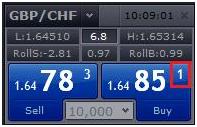Good morning Traders,
Pips
“PIP” stands for Point In Percentage. More simply
though, a pip is what we in the FX world consider a “point” for calculating
profits and losses. In a standard (10k) account, each pip is worth
roughly one unit of the currency in which your account is denominated. If
your account is denominated in USD, for example, each pip (depending on the
currency pair) is worth about $1. In a micro account, each pip is worth
roughly 1/10th the amount it would be worth in a standard account -- so about
$0.10.
In all pairs involving the Japanese Yen (JPY), a pip is the
1/100th place -- 2 places to the right of the decimal. In all other
currency pairs, a pip is the 1/10,000 the place -- 4 places to the right of the
decimal.
You’ll see that in the Trading Station the digits for pips are
in a larger font. This makes them easier to see.
 At
Optionbit: we quote each currency pair with precision to 1/10th of
a pip. So you’ll see quotes listed to the 1/1,000th place for JPY
pairs and you’ll see quotes listed to the 1/100,000th place for all other
pairs. This fraction of a pip allows price providers to bring spreads
down even further as they are not restricted to quoting in full pip
increments.
At
Optionbit: we quote each currency pair with precision to 1/10th of
a pip. So you’ll see quotes listed to the 1/1,000th place for JPY
pairs and you’ll see quotes listed to the 1/100,000th place for all other
pairs. This fraction of a pip allows price providers to bring spreads
down even further as they are not restricted to quoting in full pip
increments.
Now for how to calculate the value of a pip. There is a
simple equation.
First you start with the size of your trade. Micro lots
are 1k, so if you want the value of a pip for a micro lot you start with
1,000. If you want the value of a pip for a standard lot, you start with
10,000. You then multiply your trade size by one pip for the pair that
you are trading.
I may have lost some people there so we’ll go through an
example.
In my example here we are going to calculate the value of a pip
for one 10k lot of EUR/USD.
So since I am using standard 10k lots, I’m starting with
10,000. I multiply 10,000 by .0001 since 1/10,000th is a pip for all
pairs (except JPY pairs).
That gets me a value of 1. That will be valued in the
“counter currency” (second currency) of the pair that I am trading. In
this example, I am trading EUR/USD, so USD is the counter currency of the
pair. One pip is worth 1 USD dollar for one 10k lot of EUR/USD.
If my
Optionbit: account is based in US Dollars, then I will see $1 of
profit or loss on my account for every 1 pip move that the EUR/USD makes in the
market.
Now, if my
Optionbit: account is based in British Pounds (GBP), I
would have to convert that $1 USD into Pounds. To do so, I just divide by
the current GBP/USD exchange rate which at the time of writing is 1.5829.
I’m dividing here because a Pound is worth more than a USD, so I know my answer
should be less then 1.1 divided by 1.5829 is 0.6318 Pounds.
So now I know that if I have a Pound based account, and profit or lose one pip
on 1 10k lot of EUR/USD, I will earn or lose 0.6318 Pounds.
Let’s do another example of GBP/JPY.
Again we’ll go with a one 10k lot trade.
This time a pip is .01 because it is a JPY pair.
10,000 times .01 is 100. Again, that “100” is in terms of
the counter currency, so it is 100 Japanese Yen (JPY).
Now we need to convert that 100 JPY to the denomination of your
account. If you have a USD based account, then you take the 100 JPY and
divide it by the USD/JPY spot rate, which at of the time of writing is
91.09. That gets you an answer of $1.098 per pip.
To help understand pips and pip calculations even further you
may want to consider doing some practice calculations on your own.
To make things easy for you Optionbit: : displays the value of a pip for
each currency pair in the Trading Station, in the currency that your account is
based in. In the advanced Dealing rates view you’ll see it shown between
the “Roll S” and “Roll B” fields.
In the Simple Dealing Rates view you’ll see it listed under the
Pip Cost column.
DailyFX provides forex news
and technical analysis on the trends that influence the global currency
markets.
Learn forex trading with a free
practice account and trading charts from




No comments:
Post a Comment